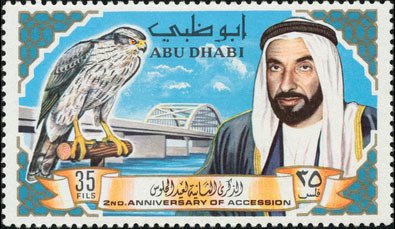Stamp: Northern Goshawk (Accipiter gentilis), Bridge, Sheik (Abu Dhabi 1969)
Northern Goshawk (Accipiter gentilis), Bridge, Sheik (Abu Dhabi 1969)
01 January (Abu Dhabi ) within release National Development goes into circulation Stamp Northern Goshawk (Accipiter gentilis), Bridge, Sheik face value 35 United Arab Emirates fils
| Stamp Northern Goshawk (Accipiter gentilis), Bridge, Sheik in catalogues | |
|---|---|
| Michel: | Mi:AB 51 |
| Stamp Number: | Sn:AB 51 |
| Yvert et Tellier: | Yt:AB 51 |
| Stanley Gibbons: | Sg:AB 51 |
Stamp is horizontal format.
Also in the issue National Development:
- Stamp - Main building of the airport of the city of Abu Dhabi face value 10;
- Stamp - Northern Goshawk (Accipiter gentilis), Bridge, Sheik face value 35;
Stamp Northern Goshawk (Accipiter gentilis), Bridge, Sheik it reflects the thematic directions:
A head of state (or chief of state) is the public persona that officially represents the national unity and legitimacy of a sovereign state. In some countries, the head of state is a ceremonial figurehead with limited or no executive power, while in others, the head of state is also the head of government. In countries with parliamentary governments, the head of state is typically a ceremonial figurehead that does not actually guide day-to-day government activities and may not be empowered to exercise any kind of secular political authority (e.g., Queen Elizabeth II as Head of the Commonwealth). In countries where the head of state is also the head of government, the president serves as both a public figurehead and the actual highest ranking political leader who oversees the executive branch (e.g., the President of the United States).
Birds (Aves), a subgroup of Reptiles, are the last living examples of Dinosaurs. They are a group of endothermic vertebrates, characterised by feathers, toothless beaked jaws, the laying of hard-shelled eggs, a high metabolic rate, a four-chambered heart, and a strong yet lightweight skeleton. Birds live worldwide and range in size from the 5 cm (2 in) bee hummingbird to the 2.75 m (9 ft) ostrich. They rank as the class of tetrapods with the most living species, at approximately ten thousand, with more than half of these being passerines, sometimes known as perching birds. Birds are the closest living relatives of crocodilians.
Birds of prey or predatory birds, also known as raptors, are hypercarnivorous bird species that actively hunt and feed on other vertebrates (mainly mammals, reptiles and smaller birds). In addition to speed and strength, these predators have keen eyesight for detecting prey from a distance or during flight, strong feet with sharp talons for grasping or killing prey, and powerful, curved beaks for tearing off flesh. Although predatory birds primarily hunt live prey, many species (such as fish eagles, vultures and condors) also scavenge and eat carrion
A bridge is a structure built to span physical obstacles without closing the way underneath such as a body of water, valley, or road, for the purpose of providing passage over the obstacle. There are many different designs that each serve a particular purpose and apply to different situations. Designs of bridges vary depending on the function of the bridge, the nature of the terrain where the bridge is constructed and anchored, the material used to make it, and the funds available to build it.
Animals are multicellular, eukaryotic organisms of the kingdom Animalia (also called Metazoa). All animals are motile, meaning they can move spontaneously and independently, at some point in their lives. Their body plan eventually becomes fixed as they develop, although some undergo a process of metamorphosis later on in their lives. All animals are heterotrophs: they must ingest other organisms or their products for sustenance.





